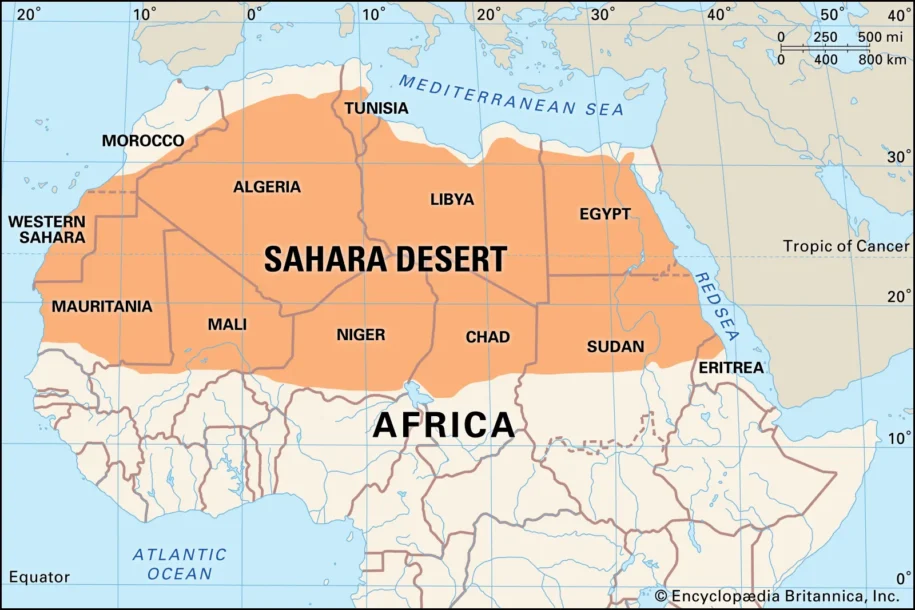The Sahara Desert is more than just an expanse of golden sands; it is a world of wonder, history, and intrigue. Spanning an incredible area across North Africa, this vast desert captures the imagination of travelers, scientists, and filmmakers alike. As the largest hot desert in the world, it has shaped the lives, cultures, and ecosystems within its reach. In this article, we dive into 15 fascinating facts about the Sahara Desert, uncovering the mysteries and marvels of this iconic landscape.
Understanding the Sahara: The World’s Largest Hot Desert
The Sahara is often associated with endless sand dunes under a blazing sun, but there’s much more to it. While it is the largest hot desert on Earth, it’s only the third largest desert overall, following the icy expanses of Antarctica and the Arctic. Covering over 9.2 million square kilometers, the Sahara stretches across 11 countries, including Morocco, Algeria, Tunisia, Libya, Egypt, and Chad. Its enormous size makes it a defining feature of the African continent, influencing weather patterns, cultures, and ecosystems for millennia.
The Vast Expanse: How Big is the Sahara Desert?
To truly grasp the enormity of the Sahara, consider this: it is nearly the size of the entire United States. Its vastness encompasses rocky plateaus, sand seas, mountain ranges, and fertile oases. Despite its reputation as a barren wasteland, the Sahara’s diversity in terrain makes it a dynamic and captivating environment. While only 25% of its surface is covered in sand dunes, the rest includes gravel plains, salt flats, and volcanic remnants.
The Origin of ‘Sahara’: What’s in a Name?
The word “Sahara” comes from the Arabic term “Sahra,” meaning desert. This simple yet descriptive name highlights its defining characteristic: aridness. For centuries, the Sahara has been known as a challenging and unforgiving landscape, but its name carries a sense of mystique and allure that draws explorers and adventurers from around the world.
Saharan Sand Dunes: Nature’s Skyscrapers
The iconic sand dunes of the Sahara, also called ergs, are some of the tallest natural formations of their kind. Rising up to 180 meters in height, these dunes are nearly half as tall as the Empire State Building. The most famous dunes are found in Morocco’s Erg Chebbi near Merzouga, where their golden peaks glow under the desert sun. These shifting sands are shaped by strong winds and stand as testaments to the desert’s raw, untamed beauty.
Life in the Sahara Desert: Adaptation and Survival
Contrary to its reputation as a lifeless desert, the Sahara is home to a variety of flora, fauna, and human communities. Indigenous tribes, such as the Tuareg and Berbers, have thrived in this harsh environment for centuries. These nomadic groups are known for their exceptional knowledge of the terrain, as well as their ability to adapt to extreme conditions. Their livelihoods often revolve around camel herding, trading, and crafting, showcasing remarkable resilience and resourcefulness.
Temperature Extremes: Surviving the Sahara’s Heat
The Sahara is notorious for its scorching temperatures, particularly during the summer months when it can reach between 38°C and 46°C (100°F to 115°F). However, the desert’s temperature fluctuations are extreme; at night, temperatures can plummet to near freezing, especially during the winter. These extremes highlight the harshness of the Sahara’s climate and the adaptive strategies needed for survival in such an unforgiving environment.
Prehistoric Sahara: A Haven for Dinosaur Fossils
The Sahara was not always the arid desert we know today. Millions of years ago, it was a lush, green landscape teeming with life. Fossils of dinosaurs and other prehistoric creatures have been discovered across the region, offering a glimpse into its verdant past. Notable finds include the Spinosaurus, a semi-aquatic dinosaur, whose remains were uncovered in Morocco, and other fascinating species that once roamed this ancient land.
Rock Over Sand: The Surprising Terrain of the Sahara
Though images of endless sand dunes dominate popular imagination, the Sahara is predominantly rocky. Gravel plains, rugged mountains, and plateaus cover much of its surface, creating a landscape that is far more varied than expected. The Ahaggar Mountains in Algeria and the Tibesti Mountains in Chad are examples of the Sahara’s rocky grandeur, standing as reminders of the region’s complex geology.
Emi Koussi Volcano: The Sahara’s Tallest Peak
The Emi Koussi volcano in Chad is the highest point in the Sahara Desert, rising 3,415 meters above sea level. This extinct volcano is part of the Tibesti mountain range and is a prominent landmark in the otherwise flat and barren landscape. Its towering presence adds to the diverse topography of the Sahara, making it a site of geological and scientific interest.
Wildlife of the Sahara: Diversity Among the Dunes
Despite its harsh environment, the Sahara is home to a surprising variety of wildlife. Among its inhabitants are the Fennec fox, known for its large ears and nocturnal habits, the addax antelope, and various bird species. Even the elusive Saharan cheetah has adapted to life in this challenging ecosystem, showcasing nature’s incredible ability to thrive under extreme conditions.
Water in the Desert: Exploring the Sahara’s Lakes and Oases
Water is a rare and precious resource in the Sahara, yet the desert hosts over 20 lakes and numerous oases. Some of the most notable include Lake Chad, a vital source of water for surrounding communities, and the oases of Siwa in Egypt and Tafraoute in Morocco. These pockets of life provide essential sustenance for humans, animals, and plants, serving as reminders of the desert’s hidden abundance.
The Sahara in Hollywood: A Star Wars Filming Location
The Sahara’s striking landscapes have made it a popular filming location, most famously for the Star Wars series. Scenes set on the fictional planet Tatooine were shot in Tunisia, capturing the desert’s otherworldly beauty. This connection to Hollywood has further cemented the Sahara’s iconic status in global popular culture.
Climate Change and the Expanding Sahara
The Sahara has been growing over the past century, with studies indicating a 10% increase in its size due to a combination of climate change and natural fluctuations. This expansion has significant implications for the surrounding regions, affecting agriculture, water availability, and the livelihoods of millions of people.
The Sahara’s Climate Cycle: From Desert to Grassland
Interestingly, the Sahara undergoes natural climate cycles over tens of thousands of years, alternating between desert and savanna grassland. These changes are driven by shifts in the Earth’s axial tilt, which influence rainfall patterns in North Africa. This periodic transformation is a testament to the dynamic nature of our planet’s climate.
Touring the Sahara: Top Activities and Experiences
The Sahara offers visitors a wealth of unforgettable experiences. From camel trekking and sandboarding to exploring ancient ruins and stargazing under some of the clearest night skies, the desert is a treasure trove of adventure. For those seeking a unique way to experience its beauty, guided tours with Morocco Dream Safari provide a gateway to this magical landscape.
The Sahara Desert is far more than a barren wasteland. It is a vibrant, complex ecosystem with a rich history and an undeniable allure. From its towering sand dunes to its hidden lakes and ancient fossils, the Sahara continues to captivate and inspire those who venture into its vast expanse.


Leave a Reply